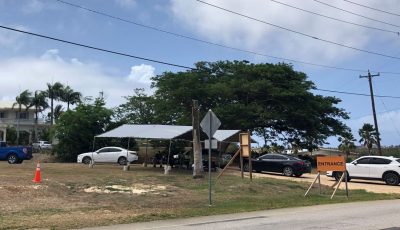Bonfire, storytelling kick off activities for Cultural Heritage Month
- Refalauwasch Advisory Council chair Henry Litulumar and Carolinian Affairs executive assistant John Tagabuel lit the bonfire to start the storytelling session. (Contributed Photos)
- 2016 Cultural Heritage Committee co-chairs Cinta M. Kaipat and Frances Sablan with Auntie Chailang Palacios, one of the evening’s storytellers.
- Co-chair Frances Sablan blesses the table.
- The beautiful and delicious cake from Herman’s Bakery.
- Auntie Chailang Palacios demonstrates the games she enjoyed as a child with help from youths in the audience.
- With L.J. Castro playing the drums in the background, the ManAntigo, Cultural Production Inc., Petlas, Simiyan Lina’la & Simiyan Manaina-ta (MACPS) Chamorro Group brought the storytelling event to a close with a performance.
The 2016 Cultural Heritage Month Committee kicked off its month-long activities with the bonfire and storytelling event last Friday, Sept. 2, 6pm at the Carolinian Utt in Garapan.
Frances M. Sablan, co-chair for the CHM committee and coordinator for the bonfire and storytelling event, said that the evening started off with the Olomwaay Band (Gus Kaipat and Gus Litulumar) performing a few numbers, accompanied by L.J. Castro, and followed by the lighting of the bonfire that was set up by the Carolinian Affairs Office under the leadership of its executive assistant to the Governor on Carolinian Affairs and Refalauwasch Advisory Council chair Henry Litulumar.
The flames of the bonfire signified the passion of the indigenous people of the Marianas. Although it started raining and the wind blew ever so strongly, the flames managed to hold up. Just like the indigenous people’s passion to pass on, teach, and perpetuate the Refaluwasch and Chamorro cultures. Amidst challenges and adversities, the indigenous people continue to do what they can as individuals and as a people to keep their culture alive.
During the lighting of the bonfire, Castro chanted “Chaifi,” the legendary Chamorro god of fire. After the blessing of the refreshments and the storytellers, entertainers, audiences, committee members, youth and elders alike had a chance to enjoy the food and drinks and the stories then began to unfold.
The first storyteller was Linda Pialur, who explained the traditional gender roles in the Refalauwasch culture. She spoke about the Refaluwasch custom of “Apparo,” the traditional way in which women must conduct themselves toward once another.
Co-chair Cinta M. Kaipat followed and reinforced the importance of “respect,” which is why “Apparo” is or was practiced in Refaluwasch culture. Then she recalled her childhood years in Pagan, and the important cultural value of “sharing.” She shared that food was always shared, for example, the fishermen’s catch was always divided and shared with the other villagers. By this time, Mother Nature decided to add her own special effects to the storytelling. The winds began to pick up and the roar of the ocean became increasingly loud as it rang throughout the Utt. Despite the help from Mother Nature, the storytelling continued.
Chailang Palacios then explained the traditional gender roles of the Chamorro men and women. She explained that she had chores to perform after school, such as sweeping, while her brother had to get “sakati” for the cow and feed the pigs. She then demonstrated the use of the charcoal-powered (coconut shells) iron introduced during the Spanish times. She also enlisted the help of some of the youths in demonstrating some childhood games that she enjoyed growing up.
Finally, Castro shared his stories of the 2004 Festival of the Pacific Arts in Palau. Unfortunately, the storytelling event had to be cut short due to the heavy rains and strong winds that whipped up around 8:30pm, drenching the sound system and lighting equipment. However, the ManAntigo, Cultural Production Inc., Petlas, Simiyan Lina’la & Simiyan Manaina-ta (MACPS) Chamorro Group didn’t want to end the storytelling event without sharing how rice was grown and processed in the Mariana Islands through song and dance.
Auntie Chailang’s presence during this performance was especially meaningful, as it was her late Mama, Tan Josepha Deleon Guerrero, who taught Auntie Chailang’s elder sister, Tan Maria P. Crisostomo, the chant that co-chair Sablan utilized in the chant she wrote. The Fa’i dance was choreographed by the late Dolores I. Marciano.
Before the CHM committee left the Utt, Dionicia Ythemar, who was amongst the members of the crowd and was awaiting her turn to tell her story, shared her stories of a Refalauwasch growing up in the CNMI, and re-emphasized the role of the genders that her sister Linda shared earlier. These stories were documented by Leni Leon and his team.
Co-chairs Sablan and Kaipat expressed their gratitude to all the donors: Saipan & Northern Islands Legislative Delegation, John Tagabuel and the hardworking staff of Carolinian Affairs Office, chair Henry Litulumar and the Refaluwasch Advisory Council, Herman’s Modern Bakery, etc., storytellers, entertainers, audiences and especially the 2016 Cultural Heritage Month Committee for making the bonfire and storytelling event a success, and for planning the upcoming 2016 CHM events/activities: Sept. 9, fashion show/speech contest; Sept. 16, cuisine night; Sept. 17, Chief Aghurubw Day celebration; Sept. 23, 13 Fishermen 30th Memorial Celebration; Sept. 24, Island Family Fun Day; Sept. 25, RMS Sunset Open Mic Presentation, Sept. 28-29, cultural symposium; Sept. 30, Uumw/Chahan Night and International Festival of Cultures every Saturday in September; and cultural demonstrations Sept 5-8 and Sept. 12-15.

































